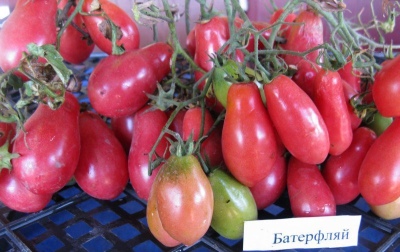
- Authors: Andreeva E.N., Sysina E.A., Nazina S.L., Bogdanov K.B., Ushakova M.I. LLC 'Selection and seed-growing company' Tomagros'
- Year of approval: 2000
- Category: grade
- Growth type: indeterminate
- Appointment: for whole fruit canning
- Ripening period: mid-season
- Ripening time, days: 110
- Growing conditions: for open ground, for film greenhouses
- Bush height, cm: up to 150
- Leaves: large, green
In recent years, many summer residents began to massively grow cherry tomatoes, the bushes of which take up a minimum of space, but give good yields. Similar types of tomatoes include a mid-season variety with the beautiful name Butterfly, which can grow both in greenhouses and in open ground.
Breeding history
This variety was bred by a group of domestic breeders (Ushakova, Andreeva, Bogdanov). The tomato species was bred relatively recently, about 20 years ago, but has already become popular among summer residents and farmers. The Butterfly variety was approved for use in 2000.
Description of the variety
The culture called Butterfly is a bush that grows up to 150 cm. The determinant plant is characterized by powerful stems, abundant thickening of dark green foliage, a strong root system and a complex inflorescence.
As a rule, over a full period, 3 brushes with a huge number of small tomatoes are formed on the bush. For the most abundant harvest, it is recommended to grow a crop in two stems. In addition, the bushes require a mandatory tie to powerful supports.
The main qualities of the fruit
Butterfly tomatoes are miniature. The average weight of one tomato is 35 grams. The shape of the fruit is unusual, egg-shaped (plum-shaped), and the color is uniform, pink-crimson. In an immature state, the fruits are characterized by a light green color, there is a dark spot at the base. Tomato peel is smooth and thin, absolutely resistant to cracking. A characteristic feature of the variety is also the uniform size of the tomatoes.
This type of tomato is versatile, so it can be eaten fresh, in salads, as well as processed, especially canned whole tomatoes.
Taste characteristics
The taste qualities of Butterfly dessert tomatoes are excellent. They have a pleasant fresh aroma, fleshy and juicy flesh, as well as pronounced sweetness without hints of sourness.
Ripening and fruiting
It is a seed crop with an average ripening period. Full maturation occurs in 110 days. Ripening in clusters is gradual, which allows you to enjoy delicious tomatoes for several months. The first fruits can be removed after July 15th.
Yield
The abundant yield of this variety is one of its advantages. With proper adherence to agricultural technology, you can collect up to 5.4 kg per 1m2. In greenhouse conditions, the yield is higher.
The timing of planting seedlings and planting in the ground
The culture is grown in seedlings. For this, the seeds are sown in pots. Before planting in open ground, seeds are sown in 60-65 days. It is recommended to use garden land with black soil. In order to speed up the process of emergence of the first shoots, polyethylene is used. After germination (2-3 leaves on a bush), you need to dive (planting bushes in separate pots). The room where the seedlings are grown should be warm and well-lit.
As soon as 6-8 true leaves appear on the bush, it can be planted in open ground. It is recommended to do this on a cloudy day or after sunset.

Growing tomato seedlings is an extremely important process, because it largely depends on whether the gardener can harvest at all. All aspects must be taken into account, from seedbed preparation to planting in the ground.
Landing scheme
A properly formed Butterfly seedling bush will be quite compact, therefore 4-5 units are planted on one square meter. The optimal planting scheme is considered to be 50 by 40 cm.

Growing and care
It is recommended to grow the culture in an area where dill, parsley, cucumbers or carrots previously grew. The soil should be dug up, breathable, saturated with mineral fertilizers, and also protected from drafts and strong winds. Butterfly tomatoes need complex agricultural technology - moderate watering, timely feeding, the formation of bushes, garter, weeding and loosening of the soil.
It is also worth noting that this type can be grown on a balcony, in a home film greenhouse.




A plant needs different micronutrients at each stage of growth. All fertilizers can be divided into two groups: mineral and organic. Folk remedies are often used: iodine, yeast, bird droppings, eggshells.
It is important to observe the rate and period of feeding. This also applies to folk remedies and organic fertilizers.
Disease and pest resistance
The plant has resistance to many diseases and viruses, however, preventive measures should be taken, since it is easier to prevent a disease than to deal with its consequences. As a prophylaxis, spraying using special solutions (insecticides) is used.


Resistant to adverse weather conditions
The culture has absolute resistance to weather fluctuations, so it can be grown in almost any climatic conditions. In the southern and central lane - in open ground, in the northern - greenhouses.
Growing regions
The culture is recommended for cultivation in all regions of the Russian Federation, Ukraine, as well as Belarus.
Review overview
Miniature Butterfly tomatoes are massively grown by gardeners in their dachas, on balconies, in miniature greenhouses. The variety is characterized as high-yielding, easy to care for, quickly adapting to weather and soil, and incredibly tasty fresh and canned.

























































































